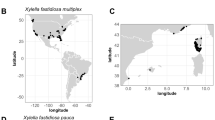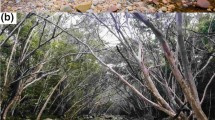Abstract
Vaccinium twig blight (caused by Phomopsis vaccinii, teleomorph Diaporthe vaccinii) is a major endemic disease on blueberries and cranberries in the Eastern and Northwestern USA and Canada. It has also been found in Europe, Chile and China. Publications on its occurrence in the USA and Canada indicate that the pathogen is limited to cool climates. Published data on worldwide occurrence were inventoried and supplemented with National Plant Diagnostic Network (NPDN) data in the USA. These occurrence and long-term climate data were entered in the niche models MaxEnt and Multi-Model Framework to predict the potential global distribution of the disease. Precipitation in the driest quarter and mean annual temperature contributed most to the prediction. The results indicate that P. vaccinii is not limited to cool climates, although the optimal annual average temperature is 10 °C according to the MaxEnt model. The models correctly predicted that the climate in the central and eastern USA and the west coast of the USA and Canada would be conducive to blueberry twig blight. Large areas in Europe, eastern Australia and New Zealand, and smaller areas in South America and East Asia would be conducive too. For the first time, the NPDN database was shown to be an important source of information for the prediction of the potential global distribution of a plant pathogen.





Similar content being viewed by others
References
Ames, G. K., Gergerich, R. C., Weidemann, G. J., & Patterson, C. A. (1988). First report of Diaporthe vaccinii on blueberry in Arkansas. Plant Disease, 72, 362.
Araújo, M. B., & Guisan, A. (2006). Five (or so) challenges for species distribution modelling. Journal of Biogeography, 33, 1677–1688.
Bosso, L., Russo, D., di Febraro, M., Cristinzio, G., & Zoina, A. (2016). Potential distribution of Xylella fastidiosa in Italy: a maximum entropy model. Phytopathologia Mediterranea, 55, 62–72.
Brazelton, C. (2013). World blueberry acreage & production. In World blueberry acreage & production report (pp. 77). US highbush blueberry council.
Brown, J. L. (2014). SDMtoolbox: a python-based GIS toolkit for landscape genetic, biogeography, and species distribution model analyses. Methods in Ecology and Evolution, 5, 694–700.
Carlson, L. W. (1963). Physiology, pathogenicity and control of fungi causing certain cranberry diseases. Madison: University of Wisconsin.
Caruso, F. L., & Ramsdell, D. C. (1995). Compendium of blueberry and cranberry diseases. St. Paul MN: American Phytopathological Society.
Caruso, F. L., Bristow, P. R., & Oudemans, P. V. (2000). Cranberries: the most intriguing native north American fruit. APSnet Features. Online. doi:10.1094/APSnetFeature-2000-1100.
Daykin, R. D., & Milholland, R. D. (1990). Histopathology of blueberry twig blight caused by Phomopsis vaccinii. Phytopathology, 80, 736–740.
Diekmann, M. (1999). Southern deciduous forests. Acta Phytogeographica Suecica, 84, 33–53.
Diekmann, M., Frison, E., & Putter, T. (1994). FAO/IPGRI technical guidelines for the safe movement of small fruit germplasm (Vol. 13). Rome: International Plant Genetic Resources Institute, Food and Agriculture Organization of the United Nations.
Dokukina, E. A. (2001). Fungal diseases of heather berry shrubs in recreational forests (PhD thesis). Moscow: Institute of Forest Science, Russian Academy of Sciences (ILAN). (in Russian)
EFSA Panel on Plant Health (PLH). (2014). Scientific opinion on the pest categorization of Diaporthe vaccinii shear. European Food Safety Authority (EFSA) Journal, 12, 28. doi:10.2903/j.efsa.2014.3774.
Elith, J., Simpson, J., Hirsch, M., & Burgman, M. (2013). Taxonomic uncertainty and decision making for biosecurity: spatial models for myrtle/guava rust. Australasian Plant Pathology, 42, 43–51.
EPPO. (2004). First report of Diaporthe vaccinii in Lithuania. EPPO Reporting Service, 6, 6.
EPPO. (2010). First record of Diaporthe vaccinii in Germany. EPPO Reporting Service, 6, 3.
EPPO. (2015). First report of Diaporthe vaccinii in Poland and its subsequent eradication. EPPO Reporting Service, 1, 3.
Farr, D. F., Castlebury, L. A., & Rossman, A. Y. (2002a). Morphological and molecular characterization of Phomopsis vaccinii and additional isolates of Phomopsis from blueberry and cranberry in the eastern United States. Mycologia, 94, 494–504.
Farr, D. F., Castlebury, L. A., Rossman, A. Y., & Putnam, M. L. (2002b). A new species of Phomopsis causing twig dieback of Vaccinium vitis-idaea (lingonberry). Mycological Research, 10, 745–752.
Galynskaya, N. A., & Liaguskiy, V. G. (2012). Highbush blueberry diseases in Belarus. Central Botanical Garden, National Academy of Sciences of Belarus, 23 (in Russian).
Galynskaya N. A., Yarmolovich V. A., Morozov O. V., Gordey D. V. (2011) A pathogenic fungi complex in young plantations of Vaccinium angustifolium Ait. In Belorussian Poozerje. Proceedings of BGTU, No 1, Forestry (pp. 224–228). (in Russian)
Guerrero, C., & Godoy, A. (1989). Detection of Phomopsis vaccinii (shear. Stevens and Bein) in highbush blueberry Vaccinium corymbosum L. Agricultura Técnica (Santiago), 49, 220–223.
Linders, E. G. A., van Damme, J. M. M., & Zadoks, J. C. (1996). Epidemics of Diaporthe adunca in experimental and in natural populations of Plantago lanceolata and the effect of partial resistance on disease development. Plant Pathology, 45, 70–83.
Lockhart, C., Hall, I., & Murray, R. (1973). Yield losses in cranberry in Nova Scotia, 1969-72. Canadian Plant Disease Survey, 53, 99–100.
Lombard, L., Van Leeuwen, G. C. M., Guarnaccia, V., Polizzi, G., Van Rijswick, P. C. J., Rosendahl, K. C. H. M., Gabler, J., & Crous, P. W. (2014). Diaporthe species associated with Vaccinium, with specific reference to Europe. Phytopathologia Mediterranea, 53, 287–299.
Martinussen, I., Rohloff, J., Uleberg, E., Junttila, O., Hohtola, A., Jaakola, L., & Häggman, H. (2009). Climatic effects on the production and quality of bilberries Vaccinium myrtillus. Agronomijas Vēstis, 12, 71–74.
Meentemeyer, R. K., Haas, S. E., & Václavík, T. (2012). Landscape epidemiology of emerging infectious diseases in natural and human-altered ecosystems. Annual Review of Phytopathology, 50, 379–402.
Milholland, R. D. (1982). Blueberry twig blight caused by Phomopsis vaccinii. Plant Disease, 66, 1034–1036.
Milholland, R. D., & Daykin, M. E. (1983). Blueberry fruit rot caused by Phomopsis vaccinii. Plant Disease, 67, 325–326.
Morozov, O. V., Gordey, D. V., Yarmolowich, V. A., & Tereshkina, N. V. (2014). Increase of resistance of lowbush blueberry (Vaccinium angustifolium ait.) against diseases in the conditions of the Belarusian poozerye. In State of art and prospects of forest non-wood resource utilization (pp. 106–112). Presented at the International workshop on state of art and prospects of forest non-wood resource utilization, Minsk, Republic of Belarus: Belarusian State University, Kostroma. (in Russian)
Narouei Khandan, H., Worner, S. P., Jones, E. E., Villjanen-Rollinson, S. L. H., Gallipoli, L., Mazzaglia, A., & Balestra, G. M. (2013). Predicting the potential global distribution of Pseudomonas syringae pv. actinidiae (Psa). New Zealand Plant Protection, 66, 184–193.
Narouei-Khandan, H., Halbert, S., Worner, S., & van Bruggen, A. C. (2016). Global climate suitability of citrus huanglongbing and its vector, the Asian citrus psyllid, using two correlative species distribution modeling approaches, with emphasis on the USA. European Journal of Plant Pathology, 144, 655–670.
National Plant Protection organization (NPPO). (2015). Diaporthe vaccinii – blueberry twig blight - on one blueberry plant at one fruit production facility in the Netherlands. Ministry of Economic affairs: Netherlands Food and Consumer, Product Safety Authority https://www.nvwa.nl/txmpub/files/?p_file_id=2208923. Accessed 14 Jan 2016.
Olatinwo, R. O., Hanson, E. J., & Schilder, A. M. C. (2003). A first assessment of the cranberry fruit rot complex in Michigan. Plant Disease, 87, 550–556.
Parker, P. E., & Ramsdell, D. C. (1977). Epidemiology and chemical control of Phomopsis canker of highbush blueberry. Phytopathology, 67, 1481–1484.
Phillips, S. J., Anderson, R. P., & Schapire, R. E. (2006). Maximum entropy modeling of species geographic distributions. Ecological Modelling, 190, 231–259.
Polashock, J. J., & Kramer, M. (2006). Resistance of blueberry cultivars to Botryosphaeria stem blight and Phomopsis twig blight. Hortscience, 41, 1457–1461.
QingHua, Y., Hongha, Z., Chen, L., & XiaoDong, L. (2015). The pathogen causing Phomopsis twig blight of blueberry. Mycosystema, 32, 959–966.
Rydin, H., Sjörs, H., & Löfroth, M. (1999). Mires. Acta Phytogeographica Suecica, 84, 91–112.
Sabaratnam, S., Wood, B., Nabetani, K., & Sweeney, M. (2015). Surveillance of cranberry fruit rot pathogens, their impact and grower education. Ministry of Agriculture, British Colombia, Canada: Interim Research Report http://www.bccranberries.com/pdfs/researchreports/2014/Sabaratnam-Impact-Fruit-Rot-Pathogens-2014.pdf. Accessed on 13 Oct 2016.
Senay, S. D., Worner, S. P., & Ikeda, T. (2013). Novel three-step pseudo-absence selection technique for improved species distribution modelling. PloS One, 8, e71218.
Shimwela, M. M., Blackburn, J. K., Jones, J. B., Nkuba, J., Narouei-Khandan, H. A., Ploetz, R. C., Beed, F., & van Bruggen, A. H. C. (2016a). Local and regional spread of banana Xanthomonas wilt (BXW) in space and over time in Kagera. Plant Pathology: Tanzania (in press).
Shimwela, M. M., Narouei Khandan, H. A., Halbert, S. E., Keremane, M. L., Minsavage, G. V., Timilsina, S., Massawe, D. P., Jones, J. B., & van Bruggen, A. H. C. (2016b). First occurrence of Diaphorina citri in East Africa, characterization of the Ca. Liberibacter species causing huanglongbing (HLB) in Tanzania, and potential further spread of D. citri and HLB in Africa and Europe. European Journal of Plant Pathology. doi: 10.1007/s10658–016-0921-y
Škvorc, Ž., Franjić, J., Krstonošić, D., Sever, K., & Alešković, I. (2011). Vegetation features of beech forests of Psunj, Papuk and Krndija mountains. Croatian Journal of Forest Engineering, 32, 174–176.
Stack, J. P., Bostock, R. M., Hammerschmidt, R., Jones, J. B., & Luke, E. (2014). The national plant diagnostic network: partnering to protect plant systems. Plant Disease, 98, 708–715.
Stiles, C. M., & Oudemans, P. V. (1999). Distribution of cranberry fruit-rotting fungi in New Jersey and evidence for nonspecific host resistance. Phytopathology, 89, 218–225.
Townsend Peterson, A., Papeş, M., & Eaton, M. (2007). Transferability and model evaluation in ecological niche modeling: a comparison of GARP and MaxEnt. Ecography, 30, 550–560.
Udayanga, D., Castlebury, L. A., Rossman, A. Y., Chukeatirote, E., & Hyde, K. D. (2014). Insights into the genus Diaporthe: phylogenetic species delimitation in the D. eres species complex. Fungal Diversity, 67, 203–229.
USDA APHIS. (2015). Treatment Manual. .https://www.aphis.usda.gov/import_export/plants/manuals/ports/downloads/treatment.pdf
Vilka, L., & Volkova, J. (2015). Morphological diversity of Phomopsis vaccinii isolates from cranberry Vaccinium macrocarpon Ait.) in Latvia. Proceedings of the Latvia University of Agriculture, 33, 8–18.
Vippen, J., & Jeffries, M. (2011). Diseases diagnosed on commercial crops submitted to the British Columbia Ministry of Agriculture Plant diagnostic laboratory in 2010. Canadian Plant Disease Survey, 91, 7–16.
Weingartner, D. P., & Klos, E. J. (1975). Etiology and symptomatology of canker and dieback diseases on highbush blueberries caused by Godronia (Fusicoccum) cassandrae and Diaporthe (Phomopsis) vaccinii. Phytopathology, 65, 105–110.
Wilcox, M. S. (1940). Diaporthe vaccinii, the ascigerous stage of Phomopsis, causing a twig blight of blueberry. Phytopathology, 30, 441–443.
Worner, S. P., Ikeda, T., Leday, G., Zealand, N., & Joy, M. (2010). Surveillance tools for freshwater invertebrates. In MAF Biosecurity Technical Paper. Wellington: Ministry of Agriculture and Forestry.
Yuen, J., & Mila, A. (2015). Landscape-scale disease risk quantification and prediction. Annual Review of Phytopathology, 53, 471–484.
Zoratti, L., Palmieri, L., Jaakola, L., & Häggman, H. (2015). Genetic diversity and population structure of an important wild berry crop. AoB Plants, 7, plv117.
Acknowledgements
This research was funded by the Esther B. O’Keeffe foundation. We thank Mike Hill and Eileen Luke for providing data on blueberry twig blight occurrence from the NPDN data base. We also express our gratitude to the following persons who provided help on P. vaccinii distribution: Cheryl Blomquist, Steve Koike, Bernardo Latorre, André Lévesque, Marco Pautasso, Roel Potting, Mariusz Szmagara, Albert Tenuta, and Dhanushka Udayanga.
Author information
Authors and Affiliations
Corresponding authors
Electronic supplementary material
ESM 1
(DOCX 100 kb)
Rights and permissions
About this article
Cite this article
Narouei-Khandan, H.A., Harmon, C.L., Harmon, P. et al. Potential global and regional geographic distribution of Phomopsis vaccinii on Vaccinium species projected by two species distribution models. Eur J Plant Pathol 148, 919–930 (2017). https://doi.org/10.1007/s10658-017-1146-4
Accepted:
Published:
Issue Date:
DOI: https://doi.org/10.1007/s10658-017-1146-4




